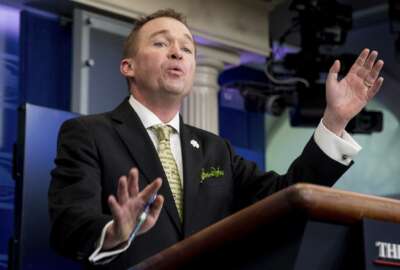
White House details how it wants civilian agencies to cut $18B in FY2017
According to budget documents that Federal News Radio obtained, the Food and Drug Administration would see $40 million in cuts to employee salaries and...
The White House has a few more details about how exactly it wants to cut $18 billion from some civilian agencies and offset significant boosts to defense and homeland security spending for the rest of fiscal 2017.
According to budget documents obtained by Federal News Radio, many agencies would see reductions to their education, grant and research programs as well as those State Department programs that offer foreign aid and assistance.
The White House also proposed a few topline cuts to some agencies and a significant reduction to a federal shared services initiative.
Many of the proposed cuts are not necessarily a surprise, as they strike similarities with the reductions President Donald Trump outlined in his fiscal 2018 budget blueprint. And much of the White House rhetoric used to detail and justify these reductions describes programs that are low or no longer priorities — or initiatives that lack substantial evidence and data to rationalize continued support from Congress.
The budget documents detailed reductions each agency could see for the remaining five months of the fiscal year — if Congress were to appropriate at the levels the White House requested for fiscal 2017.
(NOTE: Individual components are listed as separate line items from their parent departments. Some agencies also receive appropriations from multiple committees in Congress. Reductions for those agencies were combined and listed as one item.)
The Food and Drug Administration, for example, would lose $40 million in staff salaries and other expenses.
“FDA can absorb some of the reductions through administrative savings, including slower than anticipated hiring,” the budget document said.
The Homeland Security Department would lose $41 million toward its Financial Systems Modernization program, a shared services effort affiliated with the Interior Department’s Interior Business Center, which is supposed to develop financial management systems for DHS.
“The program has largely failed to deliver a timely, stable financial system for the fist DHS component, the Domestic Nuclear Detection Office, and it appears unlikely that the program will be successful in its development efforts in fiscal 2017,” the budget document said.
The White House also wants to eliminate $15 million in grants each for the National Endowment for the Arts and the National Endowment for the Humanities, two of the 19 agencies President Trump proposed to eliminate funding for entirely in his 2018 budget request.
In addition, the U.S. Army Corps of Engineers would lose $100 million from its topline budget to account for “lower priority work or for which savings can be found,” the budget document said.
The White House released its 2017 budget amendment request March 16, the same day it previewed the President’s fiscal 2018 budget blueprint. The 2017 amendment calls for an additional $3 billion in funding for DHS, which would begin to pay for the President’s executive orders on border security and immigration enforcement.
Budget experts have predicted the President’s supplemental would have a difficult time earning enough votes in the Senate and would put a burden on some civilian agencies in the last five months of the fiscal year.
As of March 29, Congress has fewer than 10 legislative days to pass some sort of funding solution. The current continuing resolution expires on Apr. 28.
Senate leadership have taken an optimistic view on the 2017 budget prospects.
“All of the committees, House and Senate leadership, are working together to try to finalize the rest of the FY 17 bill,” Sen. Roy Blunt (R-Mo.) told reporters during a March 28 press conference with Senate leadership. “My guess is that comes together better without the supplemental. That’s something that can be accomplished. We’re not quite there yet but a lot of hard work has gone into that and I’d say that job is very close to potentially having a full year update and then deal with the supplemental at a later time.”
Congress already passed one appropriations bill, the Military Construction and Veterans Affairs Appropriations Act for 2017. The House earlier this month passed the 2017 Defense Appropriations Act.
Blunt, a member of the Appropriations Committee and chairman of the Labor, Health and Human Services, Education and Related Agencies Subcommittee, said the Defense bill could be used as the vehicle to pass other funding measures.
“There’s no desire for a CR,” Senate Majority Leader Mitch McConnell (R-Ky.) said during the March 28 leadership press conference. “Democrats and Republicans are working together on this and we fully anticipate getting an outcome prior to the end of April. We have to, actually.”
Senate Minority Leader Chuck Schumer (D-N.Y.) also indicated that Democrats and Republicans were working well together to come to a budget solution.
“We Democrats have three standards, and they’re not that hard to meet,” he said his own press conference March 28. “One is no sequestration levels of funding, that’s more or less been agreed to. The second is parity between defense and non defense, and the third is no poison pill riders.”
Copyright © 2025 Federal News Network. All rights reserved. This website is not intended for users located within the European Economic Area.
Nicole Ogrysko is a reporter for Federal News Network focusing on the federal workforce and federal pay and benefits.
Follow @nogryskoWFED






